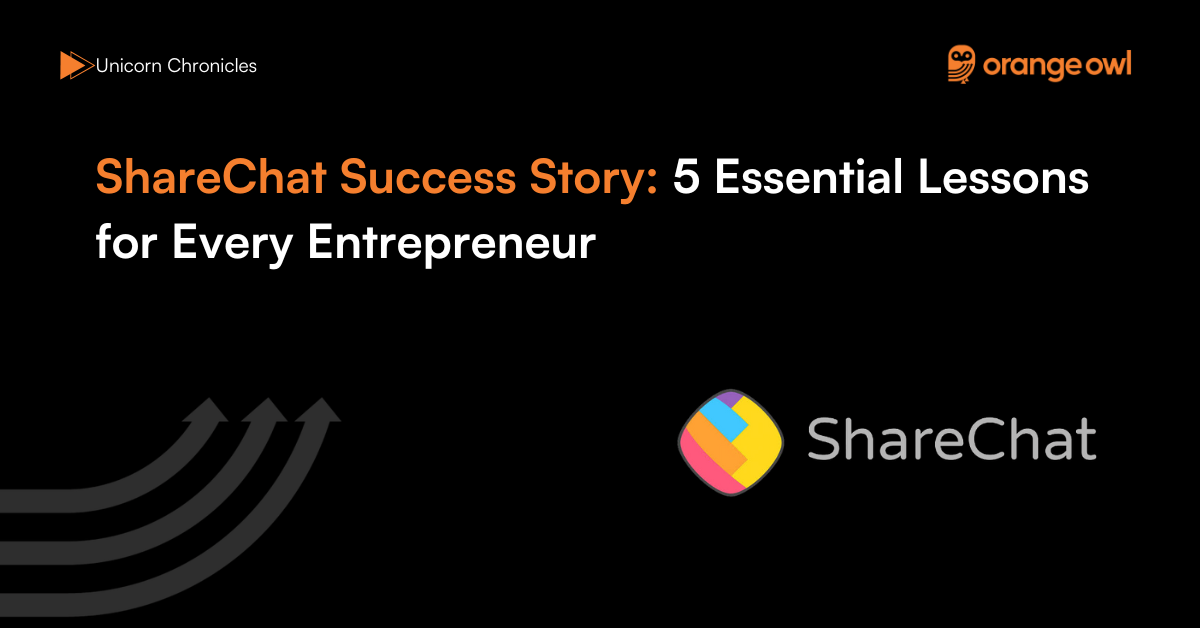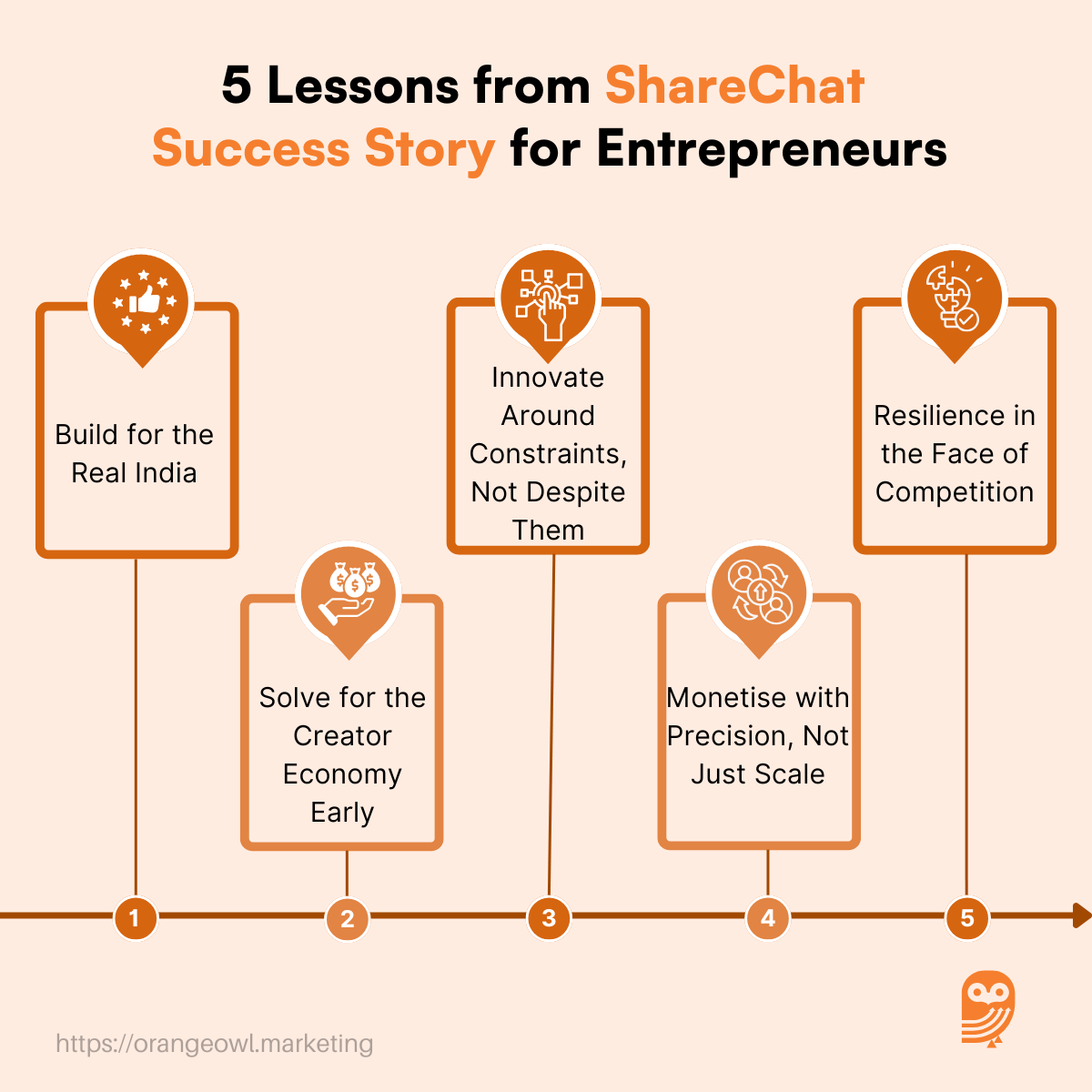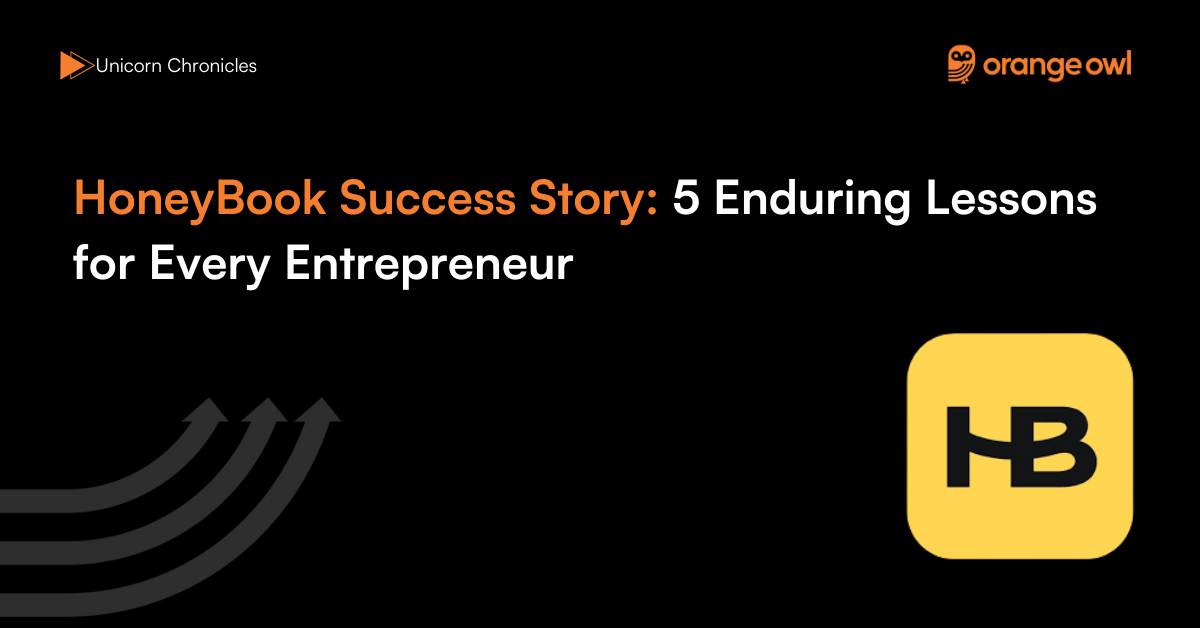ShareChat Success Story: 5 Essential Lessons for Every Entrepreneur
Vivek Goel
June 3, 2025

Table of Contents
Introduction
In the fast-growing and vibrant landscape of India’s digital social media ecosystem, ShareChat has emerged as a pioneering platform, transforming vernacular content sharing and social networking for millions of Indian users. Founded in 2015 by visionary entrepreneurs Ankush Sachdeva, Farid Ahsan, and Bhanu Pratap Singh, ShareChat was built to cater to the diverse linguistic and cultural fabric of India by enabling users to create and share content in multiple regional languages.
The company achieved unicorn status in 2021, marking a significant milestone in its journey, with a current valuation of $1.5 billion as of December 2023. This milestone is a testament to ShareChat’s unique positioning as a leading vernacular social platform, tapping into the unmet demand for regional language content in India’s vast population.
Today, ShareChat stands out with a robust user base engaging daily with content ranging from news, horoscopes, poetry, to government job notifications, supported by innovative features like shake-and-chat and open tagging. The platform’s deep focus on localised content and community engagement has enabled it to carve out a distinctive niche in the competitive media and entertainment sector, rivalling global giants like Instagram while maintaining strong roots in India’s vernacular user base.
The ShareChat success story is marked by consistent growth, backed by over $1.23 billion in funding across 16 rounds from prominent investors such as Touchstone Partners, Lightspeed Venture Partners, and SAIF Partners. With annual revenues exceeding ₹747 crore as of March 2024 and a dedicated team of 589 employees, ShareChat continues to innovate and expand its footprint.
As ShareChat gears up for an anticipated IPO shortly, its journey exemplifies how technology-driven vernacular platforms can unlock the potential of India’s digital audience, fostering inclusive growth and reshaping the social media landscape.
Origin Story
The inception of ShareChat began with a simple yet powerful vision shared by its founders — Ankush Sachdeva, Farid Ahsan, and Bhanu Pratap Singh — to build a social media platform that truly reflected the linguistic and cultural diversity of India. Officially founded on January 8, 2015, ShareChat set out to break the language barrier prevalent in digital communication by offering its app in 15 Indian languages, making social networking accessible to millions beyond just English speakers.
In the early days, the founders faced scepticism. As Ankush Sachdeva recalls,
“Many people questioned why we needed a social app in regional languages when global platforms already existed. But we believed that language was the key to unlocking India’s digital potential.”
Bhanu Pratap Singh adds,
“Our goal was to create a platform where people could express themselves in their mother tongue, share content relevant to their culture, and build communities that felt like home.”
This belief resonated deeply with India’s diverse population, helping ShareChat grow rapidly. Today, it connects over 350 million monthly active users, becoming one of the country’s largest vernacular social networks. The company’s journey from a niche idea to a unicorn in 2021, valued at $5 billion, is a testament to the founders’ vision and perseverance in fostering a truly inclusive digital India.
Business Landscape and Early Challenges
When ShareChat entered the Indian social media space, it faced intense competition from global giants like Instagram and Facebook, which already commanded massive user bases. Unlike these platforms, ShareChat’s focus was on vernacular content—an untapped market catering to India’s diverse regional language speakers. This unique positioning, while promising, came with its own set of challenges.
One of the earliest hurdles was building a product that resonated deeply across 15 different languages and cultures, ensuring the platform felt native and intuitive to users from vastly different regions. Developing and maintaining this multi-language ecosystem required substantial investment in technology and content moderation.
Additionally, user acquisition and engagement in non-metro areas posed a challenge, as internet penetration and smartphone usage were still growing. As founder Ankush Sachdeva shared,
“Our biggest challenge was to make users feel at home in their own language and culture online—something the existing platforms were not addressing.”
Monetisation was another early obstacle. With a largely vernacular user base, attracting advertisers and building sustainable revenue streams required innovation in localised content and ad formats. To overcome these, ShareChat focused on building strong community engagement through features like private messaging, open tagging, and shake-and-chat, helping users discover content and connect in meaningful ways.
The company’s ability to adapt quickly and understand the nuances of India’s linguistic diversity allowed it to carve out a significant niche, setting the stage for its eventual rise as one of India’s fastest-growing social platforms.
Growth Strategies
ShareChat’s extraordinary growth can be attributed to its deep focus on vernacular content, community building, and technology innovation tailored specifically for India’s diverse linguistic landscape. By supporting 15 Indian languages, ShareChat unlocked access to tier 2 and tier 3 cities and rural users, a market largely underserved by global social platforms.
A key pillar of ShareChat’s growth was its hyperlocal approach—curating content that resonates culturally and linguistically with millions of users. This created a highly engaged community that found value in connecting with others in their native languages, fostering strong user loyalty and organic growth.
To accelerate expansion, ShareChat adopted a strategy of strategic acquisitions and product diversification. The acquisition of Moj, a short-video platform, enabled ShareChat to tap into the booming short-form video trend and compete directly with platforms like TikTok and Instagram Reels. This move broadened ShareChat’s content offering and significantly boosted user engagement.
ShareChat also focused on building an ecosystem of creator tools, enabling content creators to produce and monetise vernacular content easily. This empowered a growing creator economy, further strengthening platform stickiness and expanding content diversity.
Recognising the importance of monetisation in regional markets, ShareChat developed innovative ad formats and partnerships tailored for local businesses, enabling advertisers to reach hyper-targeted audiences effectively.
Finally, ShareChat’s data-driven product innovation and agile development cycles allowed rapid iteration based on user feedback, ensuring the platform remained intuitive and relevant to its user base.
This multi-faceted growth strategy propelled ShareChat to become one of India’s leading social media platforms, valued at $5 billion and reaching over 350 million monthly active users.
Marketing Strategies
Marketing at ShareChat has been a masterclass in leveraging language, culture, and creators to build a powerful connection with Bharat’s digital audience. At the heart of their strategy lies a bold insight: India’s next billion users don’t speak English, and their digital experiences must be built in their languages, for their own cultures.
From the outset, ShareChat’s marketing approach was deeply rooted in regional storytelling and grassroots community engagement. Unlike global platforms that primarily focused on metro cities, ShareChat positioned itself as India’s first vernacular social media platform, supporting over 15 Indian languages. This allowed it to tap into an underserved demographic—users from Tier-2, Tier-3 cities, and rural areas—turning them into an active, loyal community.
Ankush Sachdeva, co-founder and CEO of ShareChat, explained this vision clearly:
“We didn’t just want to build another social app. We wanted to build a platform where every Indian feels at home—where language is not a barrier but a bridge.”
A cornerstone of their marketing strategy has been the creator-first philosophy. With the launch of Moj, ShareChat’s short video app, the company built one of the largest regional creator ecosystems in India. By onboarding regional influencers, especially from smaller towns, ShareChat ensured that its marketing didn’t feel like advertising—it felt like culture. Today, Moj’s creator community drives millions of impressions daily, enabling organic brand integration through challenges, branded content, and hashtag trends.
Another powerful pillar has been personalisation through AI. ShareChat’s recommendation engine ensures that users see content in their language, tailored to their interests, increasing engagement and improving the effectiveness of vernacular ad campaigns.
The launch of ShareChat Ads, a self-serve ad platform, marked the company’s foray into full-fledged monetisation. This tool allows local businesses and national brands to run hyper-targeted campaigns based on language, region, and user behaviour—something previously untapped by global platforms.
By fusing language-first UX, creator-driven engagement, and tech-enabled targeting, ShareChat has successfully redefined what marketing looks like in the next-gen digital India. It is not just running campaigns—it is fueling conversations, shaping culture, and amplifying the voices of a billion Indians.
5 Essential Lessons for Every Entrepreneur
1. Build for the Real India
When most social media platforms were targeting English-speaking, urban millennials, ShareChat’s founders—Ankush Sachdeva, Bhanu Pratap Singh, and Farid Ahsan—looked beyond the metros. They saw a massive opportunity in regional language users who were coming online for the first time.
Instead of adapting a Western model, they built a product ground up for India’s vernacular audience, supporting 15+ Indian languages, right from launch.
“We realised early that to truly go deep in India, we had to design the product for Bharat—not just translate it,” said Ankush Sachdeva.
This deep local-first mindset gave them a first-mover advantage and intense user loyalty—something every founder should consider when operating in diverse, underserved markets.
2. Solve for the Creator Economy Early
Way before the “creator economy” became a buzzword, ShareChat bet on creators as the future of engagement. With the launch of Moj, their short video platform, they enabled regional creators to express themselves, build audiences, and even earn from their content.
Rather than focusing only on users, ShareChat empowered creators, fueling a self-sustaining content ecosystem. This not only improved user retention but also made the platform a magnet for brands and advertisers.
Lesson? Support your supply-side ecosystem—they’ll grow your platform better than paid ads ever could.

3. Innovate Around Constraints, Not Despite Them
ShareChat’s early user base had limited data, low-end devices, and slower internet connections. Instead of waiting for infrastructure to catch up, the team optimised for these constraints.
They focused on lightweight design, offline experiences, and intuitive UX that made content accessible and shareable—even via WhatsApp forwards.
Entrepreneurs often chase “premium users,” but ShareChat proves that building thoughtfully for constraints can unlock massive, untapped user bases.
4. Monetise with Precision, Not Just Scale
While most platforms race to grow users, ShareChat focused on building monetisation tools suited to their audience. With ShareChat Ads, they created a self-serve platform that allows local businesses and national brands to target users based on language, location, and behaviour.
This kind of hyperlocal ad targeting is uniquely valuable in India, where culture changes every few hundred kilometres.
The takeaway: Understand your user deeply, then build monetisation models tailored to their behaviour, not borrowed from global giants.
5. Resilience in the Face of Competition
ShareChat has had to battle global giants like TikTok, Instagram Reels, and YouTube Shorts—often with deeper pockets and larger teams. But when TikTok was banned in India, ShareChat seized the moment to launch Moj in just 30 hours.
That kind of execution speed and agility helped them onboard millions of users almost overnight and compete head-to-head in one of the world’s most competitive categories.
Entrepreneurs should remember: timing and speed matter just as much as strategy. Sometimes, the fastest ship, not the biggest, wins the race.
Conclusion
ShareChat’s journey is a shining example of how deep cultural insight, technological innovation, and bold execution can build a platform that truly connects with the heart of India. From its early days as a language-first social network to becoming a multi-billion-dollar tech powerhouse, ShareChat has not just built an app—it has created a movement that celebrates regional identity, self-expression, and digital inclusion.
By empowering creators, embracing vernacular diversity, and scaling through both product excellence and strategic foresight, the company has become a cornerstone of India’s digital ecosystem.
Co-founder Ankush Sachdeva captured the vision succinctly:
“We didn’t set out to make just another social media app. We wanted to build something that felt Indian at its core—something people could call their own.”
For entrepreneurs and innovators everywhere, the ShareChat success story is a compelling reminder that authenticity, speed, and cultural relevance are the ultimate differentiators in today’s crowded digital landscape. When you build for real users with real needs, scale and impact will follow.


